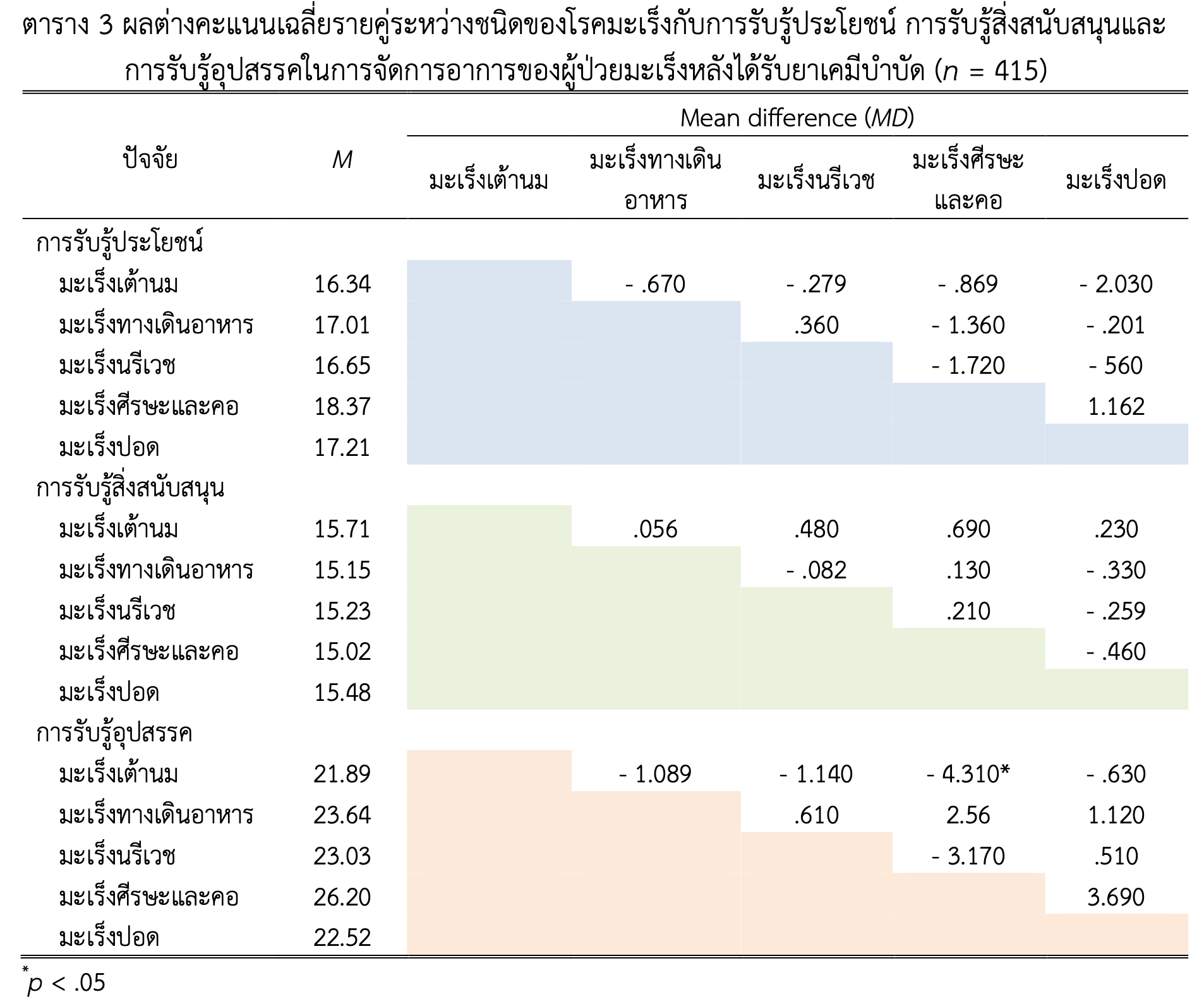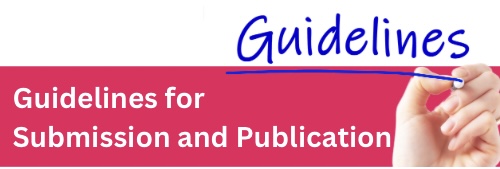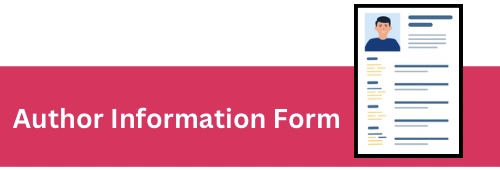RELATIONSHIPS BETWEEN PERCEIVED BENEFITS, PERCEIVED SUPPORTS, AND PERCEIVED BARRIERS TO SYMPTOM MANAGEMENT OF CANCER PATIENTS AFTER CHEMOTHERAPY DURING THE COVID-19 PANDEMIC
Keywords:
perceived benefits, perceived supports, perceived barriers, chemotherapy, COVID-19Abstract
This descriptive study aimed to examine the relationships between perceived benefits, perceived supports, and perceived barriers to symptom management in patients with cancer during the COVID-19 pandemic. Four hundred and fifteen patients with cancer undergoing chemotherapy at the National Cancer Institute were enlisted as participants in this study. The content validity of the research instruments was evaluated by a panel of experts. Reliability testing yielded satisfactory results, in which the coefficients of the questionnaires about perceived benefits, perceived supports, and perceived barriers to symptom management were .87, .92 and .87, respectively. The data analysis utilized descriptive statistics, the Pearson product-moment correlation coefficient, One-way ANOVA, and a post-hoc test by the Bonferroni method.
The results indicated that perceived benefits had a positive correlation with perceived support (r = .667) and a negative correlation with perceived barriers (r = -.244). Perceived supports were negatively correlated with perceived barriers (r = -.173). On the other hand, the study found that perceived benefits and perceived supports for symptom management in each type of cancer were not statistically significant. However, perceived barriers to symptom management in each type of cancer were statistically significant (F (4, 410) = 1.82, p = .022). Notably, patients with head and neck cancer reported perceiving more barriers than patients with breast cancer (MD = - 4.310, p < .05).
Therefore, healthcare professionals should promote patients' perceptions of the benefits and support the management of related cancer symptoms, so that patients can alleviate perceived barriers when dealing with cancer during the COVID-19 pandemic.
Downloads
References
Boonyasopun, U., Aree, P., Srisuphan, W., & Wongsuraprakit, S. (2018). Perception of benefits and barriers, perceived self efficacy, social support and eating behavior toward nutritive value and safety among women living in the inner city and outside city area. Christian University Journal, 25(1), 1-18.
Chinpatanapongsa, E., & Suwanpatikorn, K. (2014). The study of relationship between perceived benefit perceived barrier perceived self-efficacy and breast self-examination behaviour in nursing students. Journal of Public Health, 28(3), 14-29.
Cohen, A. (1977). Factors in successful occupational safety programs. Journal of Safety Research, 9(4), 168-178.
Hanna, T. P., King, W. D., Thibodeau, S., Jalink, M., Paulin, G. A., Harvey-Jones, E., . . . Aggarwal, A. (2020). Mortality due to cancer treatment delay: Systematic review and meta-analysis. British Medical Journal (Clinical research edition), 371, m4087. https://doi.org/10.1136/bmj.m4087
Hui, S. K., Huang, Y., Suher, J., & Inman, J. J. (2013). Deconstructing the "first moment of truth": Understanding unplanned consideration and purchase conversion using in-store video tracking. Journal of Marketing Research, 50(4), 445–462. https://doi.org/10.1509/jmr.12.0065
International Agency for Research on Cancer. (2022). The global cancer observatory: GCO. Retrieved from https://gco.iarc.fr
Joychoo, N., Pinyopasakul, W., & Chareonkitkarn, V. (2014). Relationships among age perceived benefits of health behaviors perceived barriers of health behaviors and health behaviors in patients with ischemic stroke. Ramathibodi Nursing Journal, 20(2), 236-248.
Karomprat, A., Chaichan, P., Santawesuk, U., & Sookprasert, A. (2017). Symptoms, symptom management and outcome in cancer patients undergoing chemotherapy. Srinagarind Medical Journal, 32(4), 326-331.
Kessels, E., Husson, O., & van der Feltz-Cornelis, C. M. (2018). The effect of exercise on cancer-related fatigue in cancer survivors: A systematic review and meta-analysis. Neuropsychiatric Disease and Treatment, 9(14), 479-494.
Khattak, S., Faheem, M., Nawaz, B., Khan, M., Khan, N. H., Ullah, N., . . . Ji, X. Y. (2022). Knowledge, attitude, and perception of cancer patients towards COVID-19 in Pakistan: A cross-sectional study. International journal of environmental research and public health, 19(13), 7926.
Leksuwankun, S., & Wonanan, P. (2020). Chemotherapy-induced nausea and vomiting. Journal of Basic and Applied Pharmacology, 42(2), 23–36.
Levin, I. R., & Rubin, S. D. (1991). Statistics for management (5th ed.). New York, NY: Prentice Hall.
Li, Y., Dang, J., Liang, D., & Yin, L. (2019). Thermal-responsive carbon monoxide (CO) delivery expedites metabolic exhaustion of cancer cells toward reversal of chemotherapy resistance. American Chemical Society, 5(6), 1044-1058.
Looyens, C., Giraud, R., Silva, I. N., & Bendjelid, K. 2021. Burkitt lymphoma and lactic acidosis: A case report and review of the literature. Physiological Reports, 9(4), 1-10.
Mhoryadee, K., Kanogsunthornra, N., & Panpakdee, O. (2018). Relationships between illness perception and pulmonary rehabilitation behaviors in persons with chronic obstructive pulmonary disease. Thai Journal of Cardio-Thoracic Nursing, 29(2), 96-110.
Miller, J. L., & Evers, J. (2022). Barriers to adherence to cancer treatments among head and neck cancer patients. Journal of the Advanced Practitioner in Oncology, 13(5), 515-523.
National Cancer Institute. (2020). Cancer registration at hospital level 2019. Bangkok: New Ordinary Printing (Thailand).
Nayak, M. G., George, A., Vidyasagar, M. S., Mathew, S., Nayak, S., Nayak, B. S., . . . Kamath, A. (2015). Symptoms experienced by cancer patients and barriers to symptom management. Indian journal of palliative care, 21(3), 349–354. https://doi.org/10.4103/0973-1075.164893
Newton, R. U., Hart, N. H., & Clay, T. (2020). Keeping patients with cancer exercising in the age of COVID-19. Journal of Oncology Practice, 16(10), 656-664.
Numsang, P., Kurat, S., Baothong, K., Somboonkit, D., Supanyabut, K., Pasaribut, R., . . . Boonmas, N. (2018). The life experiences of breast cancer patients who received chemotherapy. The Journal of Prapokklao Hospital Clinical Medical Education Center, 35(2), 140-152.
Phligbua, W., Pongthavornkamol, K., Lekdamrongkul, P., & Riangkam, C. (2020). Hematological cancer patients’ perceptions of facilitators and barriers to their participation in symptom management during hospitalization. Nursing Science Journal of Thailand, 38(4), 77–90.
Pongpradit, P., Arpanantikul, M., & Sirapo-ngam, Y. (2012). Selected factors related to health-promoting behaviors in women with breast cancer undergoing adjuvant chemotherapy. Ramathibodi Nursing Journal, 18(1), 70-83.
Selby, D., Cascella, A., Gardiner, K., Do, R., Moravan, V., Myers, J., . . . Chow, E. (2010). A single set of numerical cutpoints to define moderate and severe symptoms for the Edmonton symptom assessment system. Journal of pain and symptom management, 39(2), 241–249. https://doi.org/10.1016/j.jpainsymman.2009.06.010
Sukhokanjanachusak, K. (2021). The coronavirus 2019 (COVID-19) pandemic on treatment outcome and requirement of the cancer patient in Suratthani Hospital. Region 11 Medical Journal, 35(1), 124-136.
Treiman, K., Kranzler, E. C., Moultrie, R., Arena, L., Mack, N., Fortune, E., . . . Street, R. L. (2022). Patients' experiences with cancer care: Impact of the COVID-19 pandemic. Journal Patient Experience, 21(9), 237-437.

Downloads
Published
How to Cite
Issue
Section
License
Copyright (c) 2023 JOURNAL OF THE POLICE NURSES

This work is licensed under a Creative Commons Attribution-NonCommercial-NoDerivatives 4.0 International License.
ผลงานที่ได้ตีพิมพ์แล้วจะเป็นลิขสิทธิ์ของวารสารพยาบาลตำรวจ














